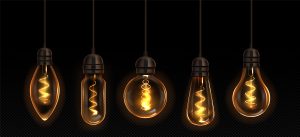
The light bulb is one of the most transformative inventions in human history, revolutionising how we live, work, and interact with our environment. Since its development in the 19th century, the light bulb has become indispensable to modern life. But what was the main purpose of the light bulb? This comprehensive article explores the light bulb’s origins, evolution, and impact, delving into its primary objective and the profound changes it brought about in society.
The Origins of the Light Bulb
- Early Innovations: The concept of artificial light has fascinated humans for centuries. Before the light bulb, people relied on natural light during the day and primitive sources like candles, oil lamps, and gas lamps at night. While functional, these sources were inefficient, hazardous, and limited in their ability to illuminate large spaces effectively.
- The Birth of the Electric Light Bulb: In the 19th century, the quest for a more reliable and efficient light source led to numerous electricity experiments. Several inventors contributed to the development of the light bulb. Still, Thomas Edison is often credited with creating the first practical and commercially viable incandescent light bulb in 1879. Edison’s bulb used a carbon filament that glowed when electricity passed through it, encased in a vacuum-sealed glass bulb to prevent oxidation.
The Main Purpose of the Light Bulb
- Illumination: The primary purpose of the light bulb was to provide a safe, reliable, and efficient source of artificial light. This invention fundamentally changed how humans interacted with their environment, extending productive and leisure hours beyond the constraints of natural daylight. The ability to illuminate the night had profound implications for various aspects of society.
- Enhancing Productivity: Before the advent of the electric bulb, work was primarily restricted to daylight hours. Factories, businesses, and homes could now operate longer and more efficiently. The light bulb enabled the rise of night shifts and 24-hour factory operations, boosting productivity and economic growth. This extension of working hours was particularly significant during the Industrial Revolution, as it supported increased production demands.
- Improving Safety: The light bulb also addressed significant safety concerns associated with earlier light sources. Candles, oil lamps, and gas lamps posed fire hazards and emitted noxious fumes. The electric light bulb eliminated these risks, providing a safer alternative for homes, businesses, and public spaces. Reducing fire incidents and health hazards was a crucial step forward in improving living conditions.
The Evolution:
- Technological Advancements: Since Edison’s time, the light bulb has undergone numerous advancements. Introducing tungsten filaments, fluorescent lights, and, more recently, LED (light-emitting diode) technology has made light bulbs more efficient, durable, and versatile. Each technological leap has further enhanced the bulb’s ability to provide illumination while reducing energy consumption and environmental impact.
- Diverse Applications: Today, bulbs are used in several applications beyond basic illumination. They are critical in medical equipment, automotive lighting, aviation, horticulture, and electronics. The development of smart lighting systems has integrated light bulbs into the broader ecosystem of the Internet of Things (IoT), allowing for automated and energy-efficient lighting solutions in homes and businesses.
The Societal Impact :
- Transforming Urban Life: The widespread adoption of the electric bulb transformed urban landscapes. Cities could now be brightly lit, improving public safety and enabling a vibrant nightlife. Streetlights became common, reducing crime rates and allowing for safer travel at night. Public spaces, theatres, and sporting events also benefited, becoming more accessible and enjoyable after dark.
- Enabling Scientific and Educational Advancements: The ability to work and study at night had significant implications for education and scientific research. Laboratories and educational institutions could extend their hours of operation, facilitating greater innovation and learning. This extended access to light contributed to advancements in various fields, accelerating technological and scientific progress.
Contact Krelum Lighting for more information
Contact us today to learn more about our extensive range of light bulbs in Johannesburg. Alternatively, please continue to browse our website to find the lighting solution that fits your needs.
